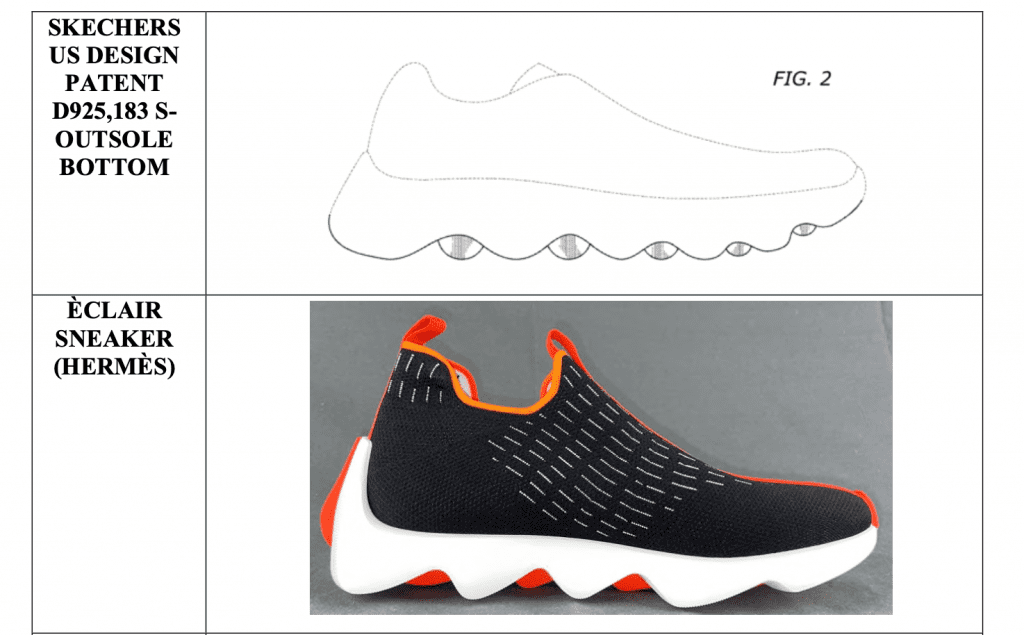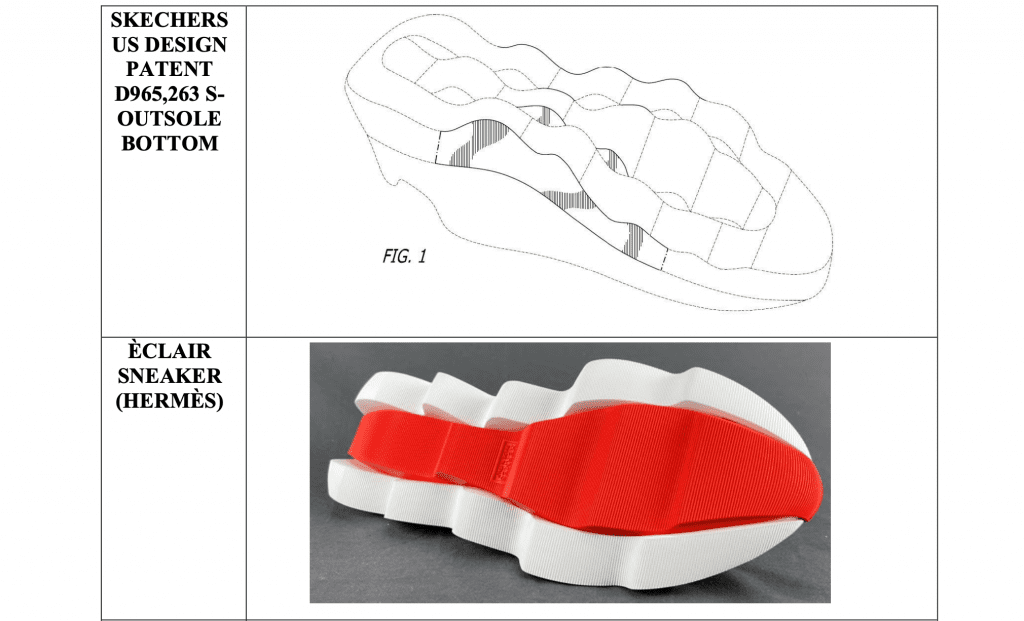Hermès is on the receiving end of a striking new lawsuit, with mass-market sneaker-maker Skechers accusing the French luxury goods brand of infringing two of its design patents by way of a couple of pricey sneaker styles. According to the 19-page complaint that it filed in a New York federal court on October 18, Manhattan Beach, California-based Skechers alleges that it maintains two design patents for “novel, non-obvious, and ornamental designs” embodied in the sole of its MASSAGE FIT sneakers, and that Hermès, which is best known for its $10,000-plus Birkin bags, infringed those patents by “making, using, selling, offering for sale, and/or importing for sale shoes” that Skechers claims “embody the inventions disclosed in [its] patents.”
In its relatively brief complaint, Skechers – which says that it has “earned its reputation as a world leader in designing cutting-edge footwear” – alleges that Hermès’s $800 Éclair and $940 Envol sneaker styles have “substantially the same sole” as those claimed in its D965,263 S and D925,183 S patents, the designs of which are “embodied in the highly successful SKECHERS GO WALK series featuring the MASSAGE FIT sole, as well as various other Skechers styles.” Specifically, Skechers is taking issue with Hermès’s alleged copying of the mid-sole and undersole design elements of its patented sneakers.

Setting out a design patent infringement claim for each of its patents, Skechers argues that Hermès “has profited and is profiting from such infringements,” and thus, is seeking monetary damages, as well as injunctive relief to bar “Hermès, its owners, officers, agents, servants, employees, attorneys, successors, and assigns, and all others in active concert or participation with Hermès, from continued infringement of the ’263 patent and the ’183 patent.”
As for the merits of Skechers’ claims, the case may not prove to be a win across the board for Skechers. “A design patent is infringed when a product looks the same as the claimed design,” Suffolk University Law School professor Sarah Burstein tells TFL, stating that the claimed design and allegedly infringing products do not have to be exactly the same, but they “need to be very similar.” In the event that “the accused design and the claimed design are not plainly dissimilar, looking at them in a vacuum,” Burstein says that “the court (or jury) can also consider other pieces of prior art, which may narrow the presumptive scope of the design patent.”

With that in mind, she says that Hermès’s sneakers “do not look similar enough, under this test, to infringe the ’183 patent, [as] there are significant visual differences including the shapes of the heels and the toe portions.” Because the ’263 patent uses dotted lines to disclaim parts of the sole shape, “it has a broader scope,” per Burstein. Since Skechers also specifically disclaims the heel and toe portions that are the most dissimilar, it will be “a closer question on infringement,” and thus, “this might be a case where consideration of the prior art might be helpful.”
Reps for Hermès were not immediately available for comment on the lawsuit. Both of the allegedly infringing Hermès sneaker styles were still available for purchase on its e-commerce site as of the time of publication.
THE BIG PICTURE: While it is not particularly common to see the likes of Hermès on the defendant side of an infringement litigation (or the plaintiff side either, frankly, as it is not as litigious as some of its peers), the lawsuit, nonetheless, falls somewhat neatly in line with the relative frequency of litigation in the footwear space, where product lifecycles tend to be longer than those in fashion (save for things like staple handbags, footwear, and accessories), R&D costs tend to be significant, and intellectual property protection – from trade dress to design patents – is common.
Citing its practice of “invest[ing] tremendous resources into research and development to introduce fresh, unique and exciting footwear technology” and the need to “seek legal recourse when competitors blatantly tread on our rights,” Skechers has waged infringement cases over its “Go Walk” design patents in the past, including against Steve Madden and Reebok. Meanwhile, this summer, it filed – and has since settled – an unrelated trademark lawsuit against Brooks, accusing its fellow sneaker-maker of infringing and diluting its “famous ‘S’ logo” by using a “confusingly similar ‘5’ mark” on footwear. At the same time, Skechers is no stranger to being sued for infringement, with Nike filing more than one suit against it, stemming from what the Swoosh called a larger pattern of Skechers “copying its competitors’ designs and using innovative technologies developed by others to gain market share instead of innovating its own designs and technologies.”
The case also comes as fashion and luxury brands continue to place notable weight on athleticwear and footwear to cater to a broader pool of consumers, including millennials and Gen-Z, while also “grabbing market share from traditional sportswear brands like Nike and adidas.” This summer, British automaker McLaren, for instance, announced that it would introduce footwear by way of a tie-up with sneaker-maker Athletic Propulsion Labs. At the same time, Thom Browne has been busy expanding its footprint beyond tailoring into sportswear and athletic-style footwear offerings, which has prompted a clash with adidas. And maybe most famously, Balenciaga launched the $895 Triple S sneaker in 2017, and the Track sneaker a year later with striking success. (Balenciaga nabbed a U.S. patent for the design of the latter.)
Brands across the board have routinely amassed – and enforced – rights in source-indicating designs and novel inventions, but sportswear brands, in particular, “are applying for more trademarks and design patents to protect their designs,” including silhouettes, lawyer Zak Kurtz of the Sneaker and Streetwear Law Firm tells TFL. The increase in trademark and design patent filings (and companies’ enforcement of such protections) demonstrates “how important things like sneaker silhouettes, for example, can be to a brand,” especially in the increasingly crowded and competitive athletic footwear market, which is expected to reach $165 billion in value by 2030, according to Allied Market Research.
UPDATED (Apr. 26, 2023): The parties have reached a settlement, with Skechers moving to “voluntarily dismiss all claims against Defendant Hermès of Paris, Inc. with prejudice in accordance with, and subject to the terms of, the confidential settlement agreement dated April 24, 2023, with Skechers and Defendant Hermès of Paris, Inc. each to bear their own fees and costs.”
The case is Skechers U.S.A., Inc., et al. v. Hermès International, et al.,1:22-cv-08862 (SDNY).














